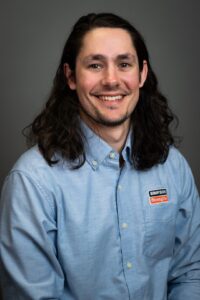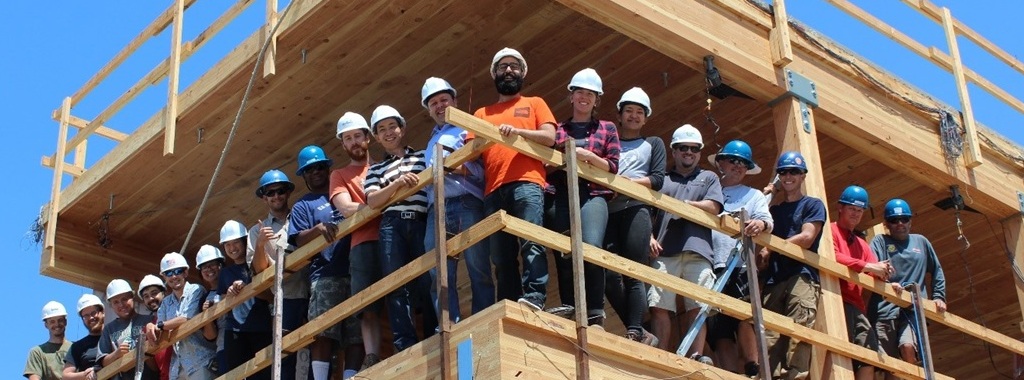Brian DeMeza’s journey from pursuing his Master of Science degree at Oregon State University (OSU) to his current role as a Senior Field Engineer at Simpson Strong-Tie has brought him full circle with his recent involvement in the six-story NHERI TallWood project. His hands-on experience in this project played a pivotal role in shaping his passion and focus on mass timber as a potential career path.

After finishing my first year at OSU as a teaching assistant, I joined an established research project focused on a two-story mass timber structure tested on UCSD’s outdoor shake table. The study analyzed two ballon-type designs of rocking walls and platform frame systems, with various groups contributing to different design elements. My group’s specific focus was on the CLT floor and roof diaphragms. The floor diaphragms consisted of bare CLT panels spanning the short direction, while the roof diaphragm spanned the long direction and consisted of a composite timber-concrete slab. Our goal was to assess performance and inform potential future building code integration. I took our initial designs and translated them into a structured worksheet, offering a detailed calculation framework for the project’s deliverables. This work ensured clarity and consistency in our approach while providing documentation to help with future work on similar designs.

One of my key contributions to the project was my onsite involvement with the test program. I spent the summer at UCSD assisting in the daily efforts to build, instrument, and test the structure. I made sure that all sensors were operational and consistently recording quality data. I also contributed by writing a Python script to help us process the data immediately following the test; this helped validate proper sensor function and interpret whether structural movements were happening as intended. The script also compiled a comprehensive report detailing each instrument’s readings in an easy-to-read PDF.

We used Simpson Strong-Tie fasteners to join the concrete topping slab to the CLT panels on the roof level. SDWH screws were installed at a 45° angle to create the composite connection. These fasteners were donated by Simpson Strong-Tie, along with all of the connection hardware, straps, and other fasteners utilized on the project.

A memorable experience for me, working on this project, was seeing a full-scale building that we built move at large earthquake levels. As someone who is originally from Georgia and did my undergraduate there, we didn’t really learn about earthquakes at all. We learned about lateral design for high winds and hurricanes, and that’s pretty much it. So Oregon State University and this project served as my introduction to seismic design. And then jumping straight into full-scale shake table testing was crazy, getting to see the building actually moving and how flexible it really is. It was very eye opening to see the real-world performance of all the building elements working together.

With the two-story test complete, the next project phase was set to kick off. The next phase in the NHERI TallWood project was the 10-story test, led by Shiling Pei of Colorado School of Mines, which was followed by the NHERI Converging Design project that tested a six-story mass timber building, led by Andre Barbosa from Oregon State University. By then, I had graduated from Oregon State University and began my career in structural engineering. I worked for a multi-discipline design firm in Portland, Oregon, where I used my schooling and previous internship experience to work on a variety of project types with all materials, even a little bridge design and inspection.

Growing out of the consulting engineer life, I transitioned into a field engineer role at Simpson Strong-Tie. Initially, I hadn’t considered working here, as my familiarity with Simpson Strong-Tie was through academia and product specification, unaware of their field engineer positions.
It felt like coming full circle when I attended a specially hosted “Simpson Day,” witnessing multiple tests on the world’s largest mass timber building on UCSD’s outdoor shake table, the NHERI TallWood test. This new project was the next iteration of the original test I assisted with and was incredible to watch in person.

Following the 10-story NHERI TallWood test, the NHERI Converging Design project included testing of a six-story building structure, which was led by my academic advisor, Dr. Andre Barbosa of Oregon State University. In one of the phases in the NHERI Converging Design project, we utilized our Yield-Link® brace connection and Yield-Link moment connection on a six-story hybrid steel and mass timber structure. It’s been fascinating observing the evolution of mass timber construction and Simpson Strong-Tie’s role in it, as it becomes increasingly embraced as a sustainable building method.

At Simpson Strong-Tie, I’ve had the opportunity to educate fellow engineers on our involvement in the mass timber field through academic partnerships, such as the NHERI TallWood project. These collaborations provide an invaluable opportunity to leverage cutting-edge research, translating data from the field into our labs to develop mass timber products that meet the specific needs of engineers and builders through rigorous research, testing, and product development.
The future looks exciting for me, for Simpson Strong-Tie, and for mass timber.


